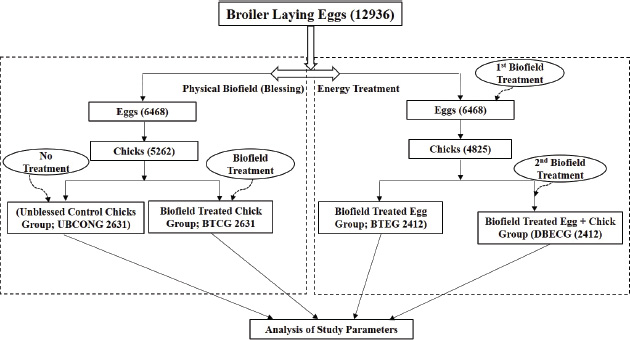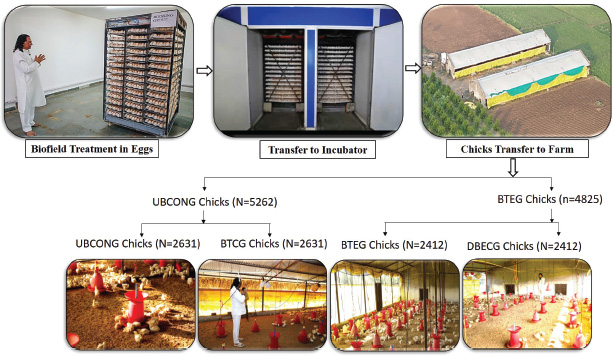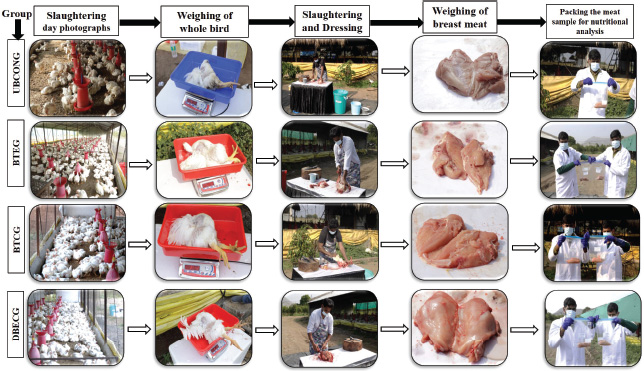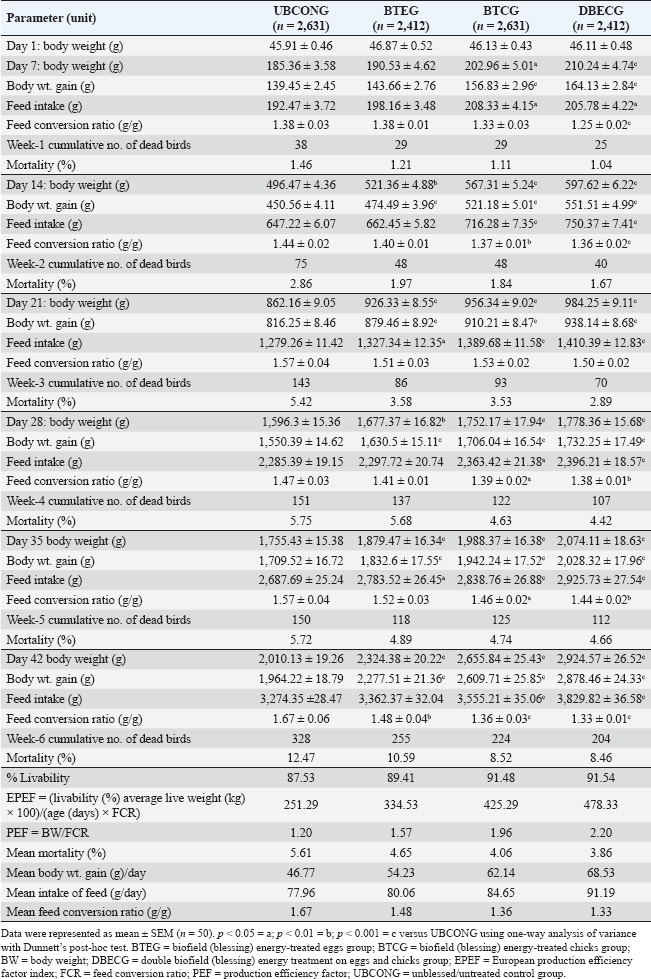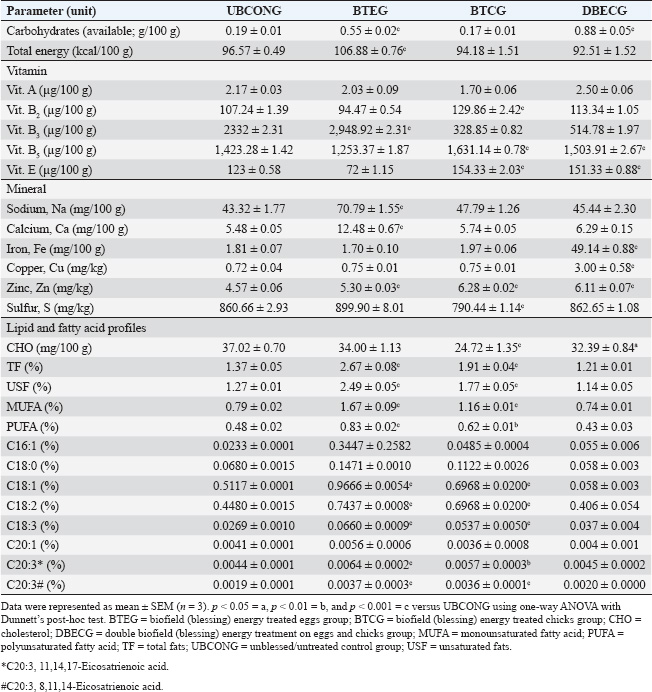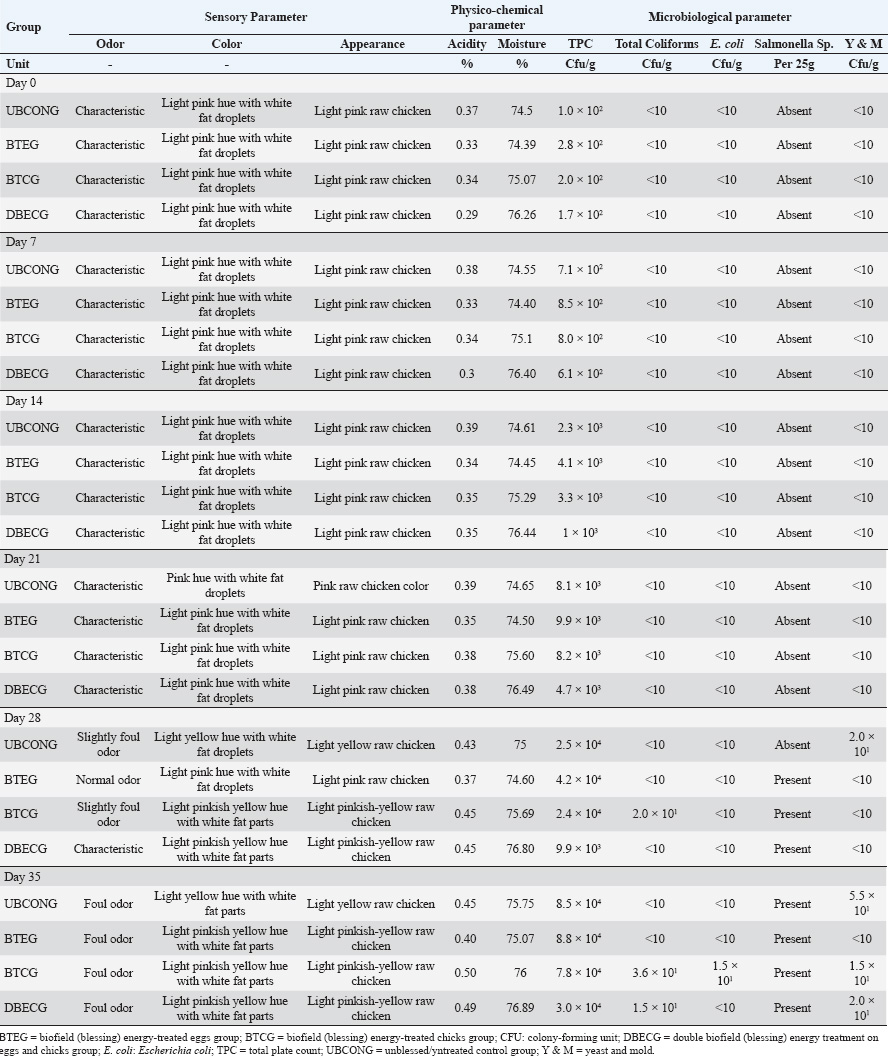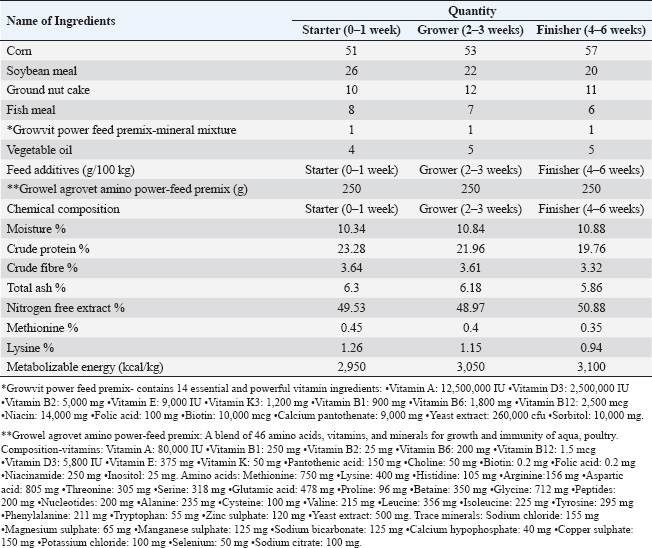
| Research Article | ||
Open Vet. J.. 2025; 15(8): 3655-3669 Open Veterinary Journal, (2025), Vol. 15(8): 3655-3669 Research Article Impact of biofield energy treatment on broiler chicken growth performance, feed efficiency, carcass characteristics, and meat qualityMahendra Kumar Trivedi1, Sandhya Parameswaran2, Chhaya Gadgoli2, Maggie Jo Alex2, Dahryn Trivedi1, Alice Branton1, Sambhu Mondal3 and Snehasis Jana3*1Trivedi Global, Inc., Research and Development, Henderson, NV, USA 2Education and Research Saraswathi Vidya Bhavan’s College of Pharmacy, Thane, India 3Trivedi Science Research Laboratory Pvt. Ltd., Research and Development, Thane (W), Maharashtra, India *Corresponding Author: Snehasis Jana. Trivedi Science Research Laboratory Pvt. Ltd., Research and Development, Thane, India. Email: publication [at] trivedisrl.com Submitted: 14/05/2025 Revised: 01/07/2025 Accepted: 09/07/2025 Published: 31/08/2025 © 2025 Open Veterinary Journal
ABSTRACTBackground: Poultry farmers often seek innovative methods to enhance meat production, such as new broiler varieties and alternative diets. Biofield (blessing) energy treatment may be a cost-effective way to increase the meat output of chickens. Aim: This study aimed to compare the growth, meat quality, nutrition, consumer preference, and shelf life of biofield-treated birds with those of the unblessed/untreated control (UBCONG). Methods: Commercial genotypes (Cobb 430Y) of white broiler eggs/chicks were used. The eggs were split into two groups: an UBCONG and a biofield (blessings) energy-treated group. Body weight and feed intake were recorded weekly, and meat quality was assessed using nutritional and sensory parameters. Results: The mean feed conversion ratio was found to be significantly better in the groups of biofield-treated eggs (BTEG; p < 0.01), biofield-treated chicks (BTCG; p < 0.001), and BTEG and chicks [Double biofield (blessing) energy treatment on both eggs and chicks group (DBECG); p < 0.001] than in the UBCONG. Edible meat weight was significantly increased in both BTCG (p < 0.05; 62.69%) and DBECG (p < 0.001; 77.19%) compared with that in UBCONG. Carbohydrate was significantly (p < 0.001) increased by 189.47% and 363.16% in BTEG and DBECG, respectively, compared to UBCONG. Vitamin B3 was significantly (p < 0.001) increased by 26.45% in BTEG compared with UBCONG. Minerals such as iron and copper were significantly (p < 0.001) increased by 2614.92% and 316.67%, respectively, in DBECG compared to UBCONG. The levels of unsaturated fats, monounsaturated fatty acid (MUFA), polyunsaturated fatty acid (PUFA), C18:1-oleic acid, C18:2-linoleic acid, and C18:3-linolenic acid were significantly (p < 0.001) increased by 96.06%, 111.39%, 72.92%, 88.91%, 66%, and 145.35%, respectively, compared with those of UBCONG. The scoring of sensory parameters (color, flavor, taste, tenderness, juiciness, and overall quality/acceptability) was significantly improved (p < 0.001) in the biofield treatment groups compared with the UBCONG. The shelf-life examination of raw chicken meat indicated that it was safe for storage for up to 21 days. Conclusion: The biofield (blessing) energy treatment significantly improved growth-related parameters compared with the UBCONG. This treatment also improved the meat quality compared to the increased levels of carbohydrate, PUFA, MUFA, and few minerals such as Ca, Fe, Zn, and Cu than UBCONG. Keywords: Biofield treatment, Growth performance, Meat quality, Sensory parameters, Broiler chicken. IntroductionThere has been a dramatic increase in the consumption of poultry meat products due to their low price, high sensory quality, higher nutritional value, and ease of processing (Barbut et al., 2008). India’s and the world’s broiler industry has grown due to consumer demand for chicken as a primary animal protein source (Devatkal et al., 2029). In response to the growing demand of the poultry market, tremendous improvements have been made in strain selection, feed conversion, breast size, fat reduction, and growth optimization, resulting in a 50% reduction in growing time and a double increase in body mass compared to the early 1950s and a 50% reduction in production costs (Anthony, 1998). Globally, chicken flesh is projected to contribute 41% of all meat protein in 2030 (Gamil et al., 2024). The modern broiler bird species has grown rapidly to reach market weight within 6 weeks due to advances in genomics, management practices, and adequate nutrition over the last few decades (Devatkal et al., 2029). Some studies suggest that there are increased cases of muscle abnormalities such as woody breasts and white stripping. In woody breast condition, chicken breast meat is very difficult to touch, pale in color, and lacks good texture (Soglia et al., 2016). White stripping is another problem associated with fast-growing broilers, leading to poor marinade absorption (Kuttappan et al., 2016). Some earlier studies reported that white striations on broiler breast fillets were caused by conditions such as “hereditary muscular dystrophy” (Julian and Asmundson, 1963) and “nutritional myopathy” (Klasing, 2008). As soon as poultry meat is distributed to the market, its shelf life significantly impacts its quality. Consumers and the market are both responsible for it. The conditions under which poultry are managed, processed, distributed, and stored influence the results. Under inadequate storage conditions, poultry meat is susceptible to rapid deterioration. Consequently, poultry and meat products are often associated with GI infections (Kozačinski et al., 2012). Poultry feed expenses represent a substantial 70% of the overall costs in chicken production, underscoring the importance of effective feed management in the industry (Willems et al., 2013). One promising strategy to mitigate these expenses is to improve feed utilization efficiency, which directly impacts profitability. The feed conversion ratio (FCR) and the European production efficiency factor (EPEF) are key indicators that measure poultry feed efficiency. These metrics are essential because they help farmers assess the balance between feed costs and the quantity of high-quality, edible meat produced from their growing birds. Farmers often turn to innovative approaches to increase efficiency, such as introducing new broiler varieties or exploring alternative diets to replace traditional fast-growing broilers. Although these options can enhance production, they frequently come with increased costs. In contrast, leveraging biofield or blessing energy therapy has emerged as a cost-effective method to boost chicken meat production in commercial fast-growing broiler operations. It presents a potentially profitable avenue for poultry farmers seeking to enhance their business without incurring significant expenses. Considering the above facts and problems in poultry farming, the authors planned to conduct a study using an alternative therapy approach, that is, biofield (blessing) energy therapy (Trivedi Effect®), to improve broiler chicken meat’s nutritional quality and overall acceptability. “The Trivedi Effect® is one of the fastest growing scientific phenomena in the field of complementary and alternative medicine system in which renowned biofield energy practitioners can harness this subtle form of energy from the universe and transmit it to living organisms for balance/restore the flow of energy and non-living objects for structural alteration” (Trivedi and Tallapragada, 2008; Trivedi et al., 2014). The Trivedi Effect® is a biofield energy treatment approach that has been scientifically validated and widely reported based on data from preclinical (cell-based and animal-based) and clinical (human) studies (Trivedi et al., 2024b; Branton et al., 2025). This study was based on the potential impact of the Trivedi Effect on livestock, specifically poultry, and the significant demand for poultry products as a primary food source in everyday human life. Therefore, this study evaluated the impact of the Trivedi Effect® on the production yield and quality of chicken meat with respect to the unblessed/untreated control (UBCONG) using various parameters viz. live body weight (BW), FCR, EPEF index, nutritional content, sensory parameters, and chemical/microbiological shelf-life study. Materials and MethodsAnimal ethics and the study facilityAll animals were handled with humane care with due regard for their welfare. The animal care complied with the regulations of the Committee for Control and Supervision of Experiments on Animals (CCSEA), Ministry of Environment and Forest, Govt. of India. This study was conducted at Anand Hatcheries Pvt. Ltd., Nasik, India (Reg. No. UDYAM-MH-23-0177371). The research conducting Institute, Saraswathi Vidya Bhavan’s College of Pharmacy (SVBCP), Dombivli East, Thane, Maharashtra, was registered (Reg. No. 704/PO/Re/S/2002/CCSEA) for the experiment on animals with the CCSEA. The animals (eggs and chicks) were used in this experiment following the protocol approved (SVBCP/IAEC/MKT/DCF/24-25/87) by the Institutional Animal Ethics Committee (IAEC), and the husbandry conditions were maintained as per the recommendations of the CCSEA. Experimental design and farm managementCommercial genotypes (Cobb 430Y) laying eggs (6,468 × 2=12,936) were sourced from Anand Hatcheries Pvt. Ltd., with the breed name white broiler chicks. The broiler chicken eggs (12,936 number) were equally divided into two groups before incubation, that is, UBCONG and biofield-treated egg group (BTEG), as shown in Figure 1. Briefly, the incubation duration in both groups was 456 hours (19 days). Eggs were fertilized through candling and then transferred to hatchers for the next 48 hours for the control and biofield energy treatment groups. All groups were treated for a full-time incubation period of 21 days (504 hours). Dead-in-shell were recorded for each group individually and then transferred to the respective farms for growing. The BW of the chicks was determined immediately after they reached the farm. A rectangular-shaped poultry house was constructed with iron poles. The shed was covered with iron wire, and an asbestos sheet was used as the roof to provide adequate ventilation. The floor was well-cemented and covered with wood shavings. A 200-W electric light bulb was used as a source of light and heat to provide adequate temperature and light. For the first 2 weeks, the pens were covered with tarpaulin to conserve heat for the chicks. The brooders were strategically located to provide heat for 24 hours for 4 weeks. Chicks were provided with a sugar solution and drinking water after arrival at the farm to minimize transportation and handling stresses. There was sufficient ventilation and 12 hours of natural light, and the entire farm is covered with iron wire mesh. The control and treatment birds were grown under the same environmental conditions. A digital hygrometer was used to measure temperature and relative humidity (RH). To overcome the effects of environmental changes, the sheds were situated in the same geographical region. The starter (0–1 week), grower (2–3 weeks), and finisher (4–6 weeks) broiler feeds were used in all experimental groups. The same feed was provided to the control and treatment groups twice a day. The details of the feed composition are provided in a supplementary document (Annexure S1). Clean water was provided to both groups of birds at all times. No medicines were provided during the study. In the hatchery, the chicks were vaccinated on day 1 by spraying Lasota vaccine at a flow rate of 300 ml/min, keeping a distance of approximately 30 cm above the chicks.
Fig. 1. Schematic details of the test system allocation and study design. Biofield (blessing) energy treatment strategyThe broiler chicken eggs (12,936) were divided into two groups before incubation, that is, the UBCONG and the biofield (blessing) energy-treated egg group, as per the schematic diagram in Figure 1. The control eggs group was not receiving any treatment, labeled as the UBCONG, and the BTEG group received in-person (physical presence) BTEG (Trivedi Effect®) for approximately 5 minutes at Anand Hatcheries, Nashik, Maharashtra, India, by an experienced (>15 years) renowned spiritual practitioner at day 0 of incubation. The biofield energy treatment (Trivedi Effect®) was provided through the healer’s unique, inherent thought intention process and prayer (channeling universal life force energy and the energy of consciousness) to the blessing group of eggs and chicks by laying his hands without touching the eggs or chicks. Figure 2 shows the exact procedure of this treatment. The newborn chicks in the UBCONG group were randomly divided into two equal groups, labeled as UBCONG (n=2,631) and biofield-treated chicks (BTCG) (n=2,631). Similarly, on day 1, newborn chicks in the BTEG group were randomly divided into two equal groups, labeled as BTEG (n=2,412) and Double biofield (blessing) energy treatment on both eggs and chicks group (DBECG) (n=2,412). On day 8 of the farming process, 50% of the chicks of the UBCONG and BTEG groups received biofield (blessing) energy treatment for approximately 5 minutes under standard farming conditions at the concern farm located in Nashik, Maharashtra, India on day 8 of the farming process. One group of BTEG chicks (biofield treatment group) received the second session of biofield energy treatment (blessing/prayer), known as the double blessing treatment in both the egg and chick groups (i.e., DBECG). Fifty percent of the UBCONG chicks also received a single session of biofield energy treatment (i.e., BTCG) (Fig. 2). Signs and symptoms, BW, feed intake, and mortalityThe chicks were monitored daily for signs and symptoms, health status, mortality, and feed intake. On every 7th day, 50 chicks were selected randomly from each group and weighed. The mortality rate, average BW, and FCR of 50 birds from each group were calculated on a weekly basis. FCR was calculated by dividing the total kilograms of feed consumed by the total kilograms of live BW produced.
Fig. 2. Pictorial view of biofield (blessing) energy treatment on eggs, transfer to incubator, hatching process, and the chicks transferred to the farm followed by biofield treatment on the chicks at a farm located in Nashik, Maharashtra, India. BTEG=biofield-treated eggs group; BTCG=biofield-treated chick group; DBECG=double biofield (blessing) energy treatment on both eggs and chicks group; UBCONG=untreated/unblessed control group.
Based on the FCR, the EPEF index was calculated for the whole batch performance. A higher side index number indicates better batch performance in terms of profitability.
Where, livability (%): percentage of birds that survived to the end of the production cycle. Average live weight (kg): the average weight of the birds at the end of the production cycle. Age (days): the age of the birds at the end of the production cycle. Nutritional analysis of chicken breast meatThe feed was withdrawn for 12 hours before slaughtering. Thirty-three individual birds were used from each group to monitor the defined nutritional parameters in this study. After dressing the birds, samples for meat (breast) were taken for nutritional content analysis (Fig. 3) and (breast and thigh) for sensory evaluation. The different nutritional parameters were analyzed in the meat sample (breast), such as carbohydrates, total energy, vitamins (A, B2, B3, B5, and E), minerals (Na, Ca, Fe, Cu, Zn, and S), lipids, and fatty acids profile viz. cholesterol, total fats, unsaturated fats (USFs), monounsaturated fatty acid (MUFA), polyunsaturated fatty acid (PUFA), C16:1 (palmitoleic acid), C18:0 (stearic Acid), C18:1 (oleic acid), C18:2 (linoleic acid), C18:3 (linolenic acid), C20:1 (eicosenoic acid), C20:3 (11,14,17-eicosatrienoic acid), and C20:3 (8,11,14-eicosatrienoic acid). Sensory evaluation of post-cooked chicken meatA consumer preference test was conducted with 25 consumers who were asked to express their impressions of four coded groups of meat samples. Consumers represented diverse age groups, socioeconomic status, and educational qualifications. Coded samples of cooked breast and thigh meat were provided to consumers for tasting, and their scores were noted. Meat samples were prepared using the same cooking methods described below in all groups. Based on six vital parameters, viz. color, flavor, odor, juiciness, tenderness, and quality/acceptability, a sensory evaluation was conducted to assess the quality of cooked chicken samples. Meat preparationPieces of chicken meat were selected randomly, ensuring uniformity in size and weight (approximately 1,250 g per sample). The meat was cut into standardized pieces (e.g., 2–3 cm thick slices or cubes) to ensure consistent cooking.
Fig. 3. Slaughtering, carcass processing, weighing, and packing of the meat sample for nutritional analysis. Cooking procedureA pot containing approximately 3,000 ml of water was brought to a boil for approximately 30 minutes, and salt was added for seasoning. Cooking continued for another 5 minutes or until the meat was tender and could be easily separated with a fork. Cooked meat samples were allowed to rest for 2–3 minutes before evaluation. AssessmentThe human senses of smell, taste, touch, sight, and tenderness were used for sensory evaluation. Consumers were assessed for sensory characteristics and provided their scores, using 9-point hedonic scale (9: extremely, 8: very much, 7: moderately, 6: slightly, 5: neither like nor dislike, 4: dislike slightly, 3: dislike moderately, 2: dislike very much, and 1: dislike extremely) was used to assessed the scores (Wichchukit and O’Mahony, 2015). Shelf-life analysisA chemical and microbiological shelf-life study was conducted on the meat samples for 5 weeks. The analysis was performed at weekly intervals as per the standard procedure. StatisticsData are expressed as mean ± SEM. The study data were analyzed using one-way analysis of variance (ANOVA) with Dunnett’s post hoc test. p < 0.05 was considered statistically significant. ResultsEvaluation of the morphological parametersThe chicks from both groups were transferred to separate broiler farms in individual houses via environmental control vehicles. The temperature and RH were recorded daily. The temperature-humidity index (THI) was calculated. The 42-day mean THI values were 22.70 (UBCONG), 22.75 (BTEG), 22.77 (BTCG), and 22.73 (DBECG), which were within the normal THI range (normal < 27.8) for broilers, as reported in the literature (Marai et al., 2001). The calculated THI data indicated no heat stress effect and/or any other environmental factors that affected the study parameters. During the 42-day farming period, mortality, feed intake, weight gain, and FCR were recorded weekly, while signs and symptoms were observed on a daily basis. Table 1 presents the results. The mean FCR was found significantly better in the BTEG (p < 0.01; 1.48), BTCG (p < 0.001; 1.36), and DBECG (p < 0.001; 1.33) than UBCONG (1.67). The mean feed intake (g/bird) was significantly higher in the BTEG (3362.37), BTCG (p < 0.001; 3555.21), and DBECG (p < 0.001; 3829.82) than UBCONG (3274.35). Weight gain was recorded to have been at maximum and statistically significant (p < 0.001) for groups BTEG (2277.51), BTCG (2609.71), and DBECG (2878.46) as compared to UBCONG (1964.22), and mean mortality was reduced in the groups; BTEG (4.65), BTCG (4.06), and DBECG (3.86) UBCONG (5.61) (Table 1). Table 1. Evaluation of broiler body weight, feed intake, and mortality during the period of 1–42 days.
Table 2. Evaluation of the carcass parameters.
Evaluation of the carcass parametersThe slaughtering, carcass yield, edible meat weight, and internal organ weight events in this study are shown in Table 2 and Figure 3. Slaughter weight was significantly (p < 0.05) better in the BTCG and DBECG than in the UBCONG. Besides, internal organ weight, skin, and feather weight were better in the BTCG and DBECG than in the UBCONG, but the data were not significant. The edible meat weight was significantly increased in both BTCG (p < 0.05; 62.69%) and DBECG (p < 0.001; 77.19%) compared to the control group, UBCONG (Table 2). Nutritional analysis of chicken breast meatThe carbohydrate content was significantly increased by 189.47% (p < 0.001) in BTEG and 363.16% (p < 0.001) in DBECG compared with UBCONG. The total energy was significantly increased by 10.68% (p < 0.001) in BTEG compared with UBCONG. Vitamin B2 levels were significantly increased by 21.09% (p < 0.001) in BTCG compared with UBCONG. Vitamin B3 levels were significantly increased by 26.45% (p < 0.001) in BTEG compared to UBCONG. Vitamin B5 was significantly increased by 14.60% (p < 0.001) in BTCG and 5.67% (p < 0.001) in DBECG compared with UBCONG. Vitamin E levels were significantly increased by 25.47% (p < 0.001) in BTCG and 23.03% (p < 0.001) in DBECG compared with UBCONG. Sodium was significantly increased by 63.41% (p < 0.001) in BTEG compared with that in UBCONG. Calcium was significantly increased by 127.74% (p < 0.001) in BTEG and non-significantly increased by 14.78% in DBECG compared with UBCONG. Iron was significantly (p < 0.001) increased by 2614.92% in the DBECG group compared with the UBCONG group. Copper was significantly increased by 316.67% (p < 0.001) in the DBECG group compared with the UBCONG group. Zinc was significantly (p < 0.001) increased by 15.97% in BTEG, 37.42% in BTEG, BTCG, and 33.70% in DBECG compared to UBCONG. Sulfur was significantly decreased by 8.16% (p < 0.001) in BTCG compared with UBCONG. Cholesterol was decreased by 33.23% (p < 0.001) in BTCG and 12.51% (p < 0.05) in DBECG compared with that in UBCONG. Total fat was decreased by 11.68% in DBECG compared to UBCONG. USF was significantly increased by 96.06% (p < 0.001) in BTEG and 39.37% (p < 0.001) in BTCG compared with UBCONG. MUFA was significantly increased by 111.39% (p < 0.001) in BTEG and 46.84% (p < 0.001) in BTCG compared with UBCONG. PUFA was significantly increased by 72.92% (p < 0.001) in BTEG and 29.17% (p < 0.01) in BTCG compared with UBCONG. Oleic acid (C18:1) was significantly (p < 0.001) increased by 88.91% and 36.17% in BTEG and BTCG, respectively, compared to UBCONG. Linoleic acid (C18:2) was significantly (p < 0.001) increased by 66% in BTEG and 55.53% in BTCG compared with UBCONG. Linolenic acid (C18:3) was significantly (p < 0.001) increased by 145.35% and 99.63% in the BTEG and BTCG, respectively, compared with UBCONG. C20:3-(11,14,17-Eicosatrienoic acid) was significantly increased by 45.45% (p < 0.001) in BTEG and 29.54% (p < 0.01) in BTCG compared with UBCONG. C20:3-(8,11,14-Eicosatrienoic acid) was significantly (p < 0.001) increased by 94.74% and 89.47% in the BTEG and BTCG, respectively, compared with UBCONG (Table 3). Sensory evaluation of post-cooked chicken meatTable 4 shows the sensory evaluation of broiler chicken. After cooking, the broiler chicken meat was assessed for sensory traits using a 9-point hedonic scale with reference to color, flavor, taste, tenderness, juiciness, and overall quality/acceptability. There were statistically significant (p < 0.001) differences found in color, flavor/aroma/smell, taste, tenderness, juiciness, and overall acceptability/quality in all the treatment groups (BTEG, BTCG, DBECG) compared with the UBCONG (Table 4). Furthermore, based on the consumer’s feedback, the biofield-treated meat was also found to be delicious, luscious, mouth-watering, soft, scrumptious, and easily digestible compared to the untreated meat. Table 3. Effects of biofield treatment on different nutritional parameters in breast meat from broilers.
Table 4: Scoring of sensory parameters on cooked chicken meat using 9-Hedonic Scale Method.
Shelf-life analysisThe chemical and microbiological shelf-life examination results of raw chicken breast meat during 35 days of storage are presented in Table 5. The table below shows the results of total plate count (TPC), total coliforms, Escherichia coli, Salmonella species, and yeast and mold (Y & M) in meat samples of breasts without skin during the 35 days of storage. Salmonella species were absent up to day 21 of storage. Other microbiological parameters like TPC, total coliforms, E. coli, and Y & M, were within the reference range up to 21 days of storage (Table 5). DiscussionPoultry makes a significant contribution as a meat-producing livestock. Increasing community welfare has demanded that producers produce poultry meat that is not only tender, affordable, and readily available. Consumers demand healthy, safe, and free food from animals that is free from antibiotic residues. Broiler chicken is a poultry commodity that provides animal protein to people worldwide (Vlaicu et al., 2024). The feed ingredients for the chicken increased in price, which in turn caused the chicken price to rise. Hence, there is an urgent need to develop cost-effective pathways for organically farmed farmers to increase chicken production with the least amount of feed ingredients. Farmers need to adopt a feeding strategy, along with an alternative path, that is most effective in achieving optimized chicken weight. Numerous studies have demonstrated that various dietary supplement systems substantially impact chicken growth performance (Oso et al., 2019). Healing through blessings and prayers is a belief found in religious traditions worldwide (Bearon and Koenig, 1990). The healing powers of blessing/prayer have been examined in randomized controlled trials (Masters, 2005; Teut et al., 2014). Blessing/prayer has been shown to improve “psychological and mental health-related symptoms” and cognitive-motor function in humans (Trivedi et al., 2024c, d; Branton et al., 2025) and non-human species, like in microbes, it improved antimicrobial susceptibility and biotype number, biochemical and hormonal biomarkers in rats (Trivedi et al., 2021), physical health, and marked recovery from pyometra in female pregnant dogs (Patil et al., 2023), and growth and meat quality of hens (Trivedi et al., 2015a). Different types of blessings and prayers, including physical presence and long-distance blessings, have resulted in psychological and biological changes that are directly or potentially associated with improved health (Trivedi et al., 2015b). There has been considerable research on the effects of Trivedi Effect® on health and well-being, including the promotion of relaxation, quality of life, and social and personal relationships, as well as the alleviation of mental anguish, stress, depression, and anxiety (Trivedi et al., 2024d). Biofield (blessing) is a spiritual and religious form of alternative and complementary therapy that has health-promoting effects and has been extensively studied through various scientific research. In this context, biofield energy-treated water on chicken showed a significant improvement in growth performance and an increase in the edible meat weight in treated chicks compared with the control chicks (Trivedi et al., 2015a). This study aimed to evaluate the effectiveness of biofield energy treatment in enhancing the growth performance and quality of chicken meat. The study findings indicated that broilers in the double biofield (blessing) energy treatment group (DBECG) exhibited higher growth rates than those in the untreated/UBCONG. The observed differences in growth rates among the treatment groups (BTEG, BTCG, and DBECG) compared with the UBCONG group highlight the importance of biofield energy therapy in maximizing broiler growth performance and meat quality. Table 5. Effects of biofield treatment on chemical and microbiological shelf-life analysis in broilers breast meat.
Furthermore, the data on feed intake confirmed that the broiler treatment groups consumed consistently higher amounts of feed than the UBCONG. Higher feed intake in the treatment groups was expected to lead to superior growth rates. It is worth noting that an increased feed intake in the biofield treatment groups (BTEG, BTCG, and DBECG) might also be attributed to an increased appetite. In terms of FCR, statistically significant differences were observed between the treatment groups (BTEG, BTCG, and DBECG) and the UBCONG. Based on this evidence, biofield energy treatment groups were more effective at converting feed into BW gain. FCR is influenced by genetics, dietary composition, and management practices. Although this study found significant differences in FCR, further studies with larger sample sizes may be required to reconfirm these findings. The findings of this study have practical implications for the broiler industry. Biofield treatment of chicks, which allowed broilers to consume feed according to their appetite, was a favorable strategy for achieving higher growth rates and better FCR and (EPEF index values. Moreover, the biofield energy treatment proved to be more cost-effective in poultry farming and resulted in higher-quality chicken meat. It is believed that litter is the main source of odor from meat chicken sheds, since the degradation of organic matter releases the majority of odorous compounds, which are typically composed of volatile and non-volatile organic compounds, such as ammonia, hydrogen sulfide, and reduced sulfur compounds, etc. (Hobbs et al., 2004; Cai et al., 2007; Mackie et al., 1998). In the present study, the biofield-treated chick group (BTCG) shed showed less odor due to a significant reduction of non-volatile organic compounds like sulfur, which is one of the advantages of poultry farming. The theoretical perspective of “Energy Medicine” encompasses different systems that use the body’s energy to promote health. A strong understanding of these treatments can be found through quantum physics. Electrotherapy typically involves low (subtle) energy interactions. Living organisms are responsive to very low levels of non-ionizing electromagnetic fields, which influence everything from cellular functions to brain activity, thoughts, and behaviors. The concept of a “biofield” describes the energy and materials that surround and permeate the human body, including measurable electrical energy and a small amount similar to Qi (Wnuk and Bernard, 2001; Rein, 2004). In this study, positive outcomes from biofield (blessings) energy treatment by the Trivedi Effect® practitioner may be due to a “channel of energy” transmitted to the eggs and chicks. These effects might align with the “Ancient Yogic Theory,” which connects thought transmission with the universe and consciousness (Carrol, 2012), potentially explained by quantum entanglement (Jana et al., 2024; Trivedi et al., 2024a) and bioresonance (Muresan et al., 2022). The therapy’s effects arise from the healer’s quantum thinking and the transmission of quantum energy to the subject, facilitating spiritual healing through instantaneous communication at the quantum level (Jana et al., 2024). A few limitations of the present study should be noted. First of all, the 6-week study duration may not provide adequate insight into the potential long-term effects of such treatments in broilers. Broiler performance and growth can be studied over a longer period with more comprehensive results. Another limitation of the study was that it was conducted in only one geographic location (Nashik, Maharashtra, India), which limited its generalizability. Future studies encompassing diverse locations and production settings would provide more robust and representative results. ConclusionIn conclusion, the use of biofield (blessing) energy treatment on eggs, chicks, and both (eggs and chicks), that is, (blessing groups: BTEG, BTCG, and DBECG), was found to be effective on cumulative weight gain, average daily weight gain, FCR, and EPEF (Broiler Index, EPEF) as compared to the UBCONG. The biofield energy treatment also improved meat quality, with significant improvements in carbohydrates, PUFA, MUFA, and several minerals, including Ca, Fe, Zn, and Cu. This study helps organic chicken farmers increase their chicken meat production by using biofield treatment as a cost-effective strategy compared to conventional poultry farming. The findings emphasize the importance of maximizing broiler growth potential. Further research is needed to validate these results. Overall, this study highlights the importance of biofield energy treatment in enhancing broiler production performance (EPEF) and offers practical implications for the industry to improve production efficiency. List of abbreviationsANOVA, analysis of variance; BTEG, biofield treated eggs group; BTCG, biofield treated chicks group; BW, body weight; CCSEA, Committee for Control and Supervision of Experiments on Animals; DBECG, Double biofield (blessing) energy treatment on both eggs and chicks group EPEF, European production efficiency factor; FCR, feed conversion ratio; MUFA, mono-unsaturated fatty acid; PUFA, poly-unsaturated fatty acid; SFA, saturated fatty acid; TES, total number of eggs set; TPC, total plate count; Y & M, yeast and mold; UBCONG, unblessed control group; USF, unsaturated fats. AcknowledgmentsThe authors would like to thank Anand Hatcheries Pvt. Ltd., Nashik, Maharashtra, India, and Divine Connection Foundation for their assistance and support during the work. The authors also express gratitude to Saraswathi Vidya Bhavan’s College of Pharmacy (SVBCP), Thane, Maharashtra, India, for providing research guidance and ethical and scientific cooperation. The authors extend their gratitude to Dr. Shailendra R Patil, India, for his enormous support and guidance in performing this study. Conflicts of interestMKT, AB, and DT were employed by Trivedi Global, Inc. Authors SP, CG, and MA were affiliated with Saraswathi Vidya Bhavan’s College of Pharmacy. Authors SM and SJ were employed by Trivedi Science Research Laboratory Pvt. Ltd. FundingThis study received no specific grant. Authors’ contributionsM.K.T., S.P., C.G., M.A., and S.J. contributed to the study conception, design, planning, execution, monitoring, and data interpretation. S.M. and D.T. wrote the first draft of the manuscript. A.B. and S.J. contributed to the manuscript’s review and editing. All authors have read and approved the final version of the manuscript. Data availabilityThe data that support the findings of this study are not openly available due to sensitivity reasons and are available from the corresponding author upon reasonable request. ReferencesAnthony, N.B. 1998. A review of genetic practices in poultry: efforts to improve meat quality. J. Muscle Foods. 9, 25–33; doi:10.1111/j.1745-4573.1998.tb00641.x. Barbut, S., Sosnicki, A.A., Lonergan, S.M., Knapp, T., Ciobanu, D.C., Gatcliffe, L.J., Huff-Lonergan, E. and Wilson, E.W. 2008. Progress in reducing the pale, soft and exudative (PSE) problem in pork and poultry meat. Meat Sci. 79, 46–63; doi:10.1016/j.meatsci.2007.07.031. Bearon, L.B. and Koenig, H.G. 1990. Religious cognitions and use of prayer in health and illness. Gerontologist 30, 249–253; doi:10.1093/geront/30.2.249. Branton, A., Trivedi, M.K., Trivedi, D., Mondal, S. and Jana, S. 2025. Effectiveness of distant/remote blessing treatment on cognitive-motor function: a randomized double-blind placebo-controlled trial. Health Psychol. Res. 13, 128098; doi:10.5296/001c.128098. Cai, L., Koziel, J.A., Lo, Y.C. and Hoff, S.J. 2006. Characterization of volatile organic compounds and odorants associated with swine barn particulate matter using solid-phase microextraction and gas chromatography-mass spectrometry-olfactometry. J. Chromatogr. A. 1102(1–2), 60–72; doi:10.1016/j.chroma.2005.10.040. Carrol S. 2012. The particle at the end of the universe: how the hunt for the Higgs Boson leads us to the edge of a new world. New York, NY: Penguin Group (USA). Devatkal, S.K., Naveena, B.M. and Kotaiah, T. 2019. Quality, composition, and consumer evaluation of meat from slow-growing broilers relative to commercial broilers. Poult. Sci. 98(11), 6177–6186; doi:10.3382/ps/pez344. Gamil, B., Salem, A.M., Arab, W.S. and Sabeq, I.I. 2024. Quality, shelf-life of broiler filets dipped in clove oil compared to peroxyacetic acid and chlorine and their consequences on inoculated Salmonella enterica. Discov. Appl. Sci. 6, 440; doi:10.1007/s42452-024-06053-3. Hobbs, P.J., Webb, J., Mottram, T.T., Grant, B. and Misselbrook, T.M. 2004. Emissions of volatile organic compounds originating from UK livestock agriculture. Food Agric. 84, 1414–1420; doi:10.1002/jsfa.1810. Jana, S., Trivedi, M.K. and Trivedi, D. 2024. Quantum biofield energy therapy for the treatment of psychological and mental health problems. In The palgrave encyclopedia of disability. Eds., Bennett, G. and Goodall, E. Cham, Switzerland: Palgrave Macmillan, pp: 1–11; doi:10.1007/978-3-031-40858-8_281-1. Julian, L. and Asmundson, V. 1963. Muscular dystrophy of the chicken. In Muscular dystrophy in man and animals. Eds., Bourne, G.H. and Golarz, N. New York, NY: Hafner, pp: 458–498. Klasing, K.C. 2008. Nutritional diseases. In Diseases of poultry, 12th ed. Eds., Saif, Y.M., Fadley, A.M., Glisson, J.R., McDougald, L.R., Nolan, L.K. and Swayne, D.E. Ames, IA: Blackwell Publishing Professional, pp: 1027–1054. Kozačinski, L., Fleck, Z.C., Kozačinski, Z., Filipović, I., Mitak, M., Bratulić, M. and Mikuš. T. 2012. Shelf life evaluation of pre-packed cut poultry meat. Veterinarski. Arhiv. 82(1), 47–58. Kuttappan, V.A., Hargis, B.M. and Owens, C.M. 2016. White striping and woody breast myopathies in the modern poultry industry: a review. Poult. Sci. 95, 2724–2733; doi:10.3382/ps/pew216. Mackie, R.I., Stroot, P.G. and Varel, V.H. 1998. Biochemical identification and biological origin in key odor components in livestock waste. J. Anim. Sci. 76, 1331–1342; doi:10.2527/1998.7651331x. Marai, I.F.M., Ayyat, M.S., Abd El-Monem, U.M. 2001. Growth performance and reproductive traits at first parity of New Zealand white female rabbits as affected by heat stress and its alleviation under Egyptian Characterizing heat stress on livestock using the temperature humidity index (THI)—prospects for a warmer... 2339 conditions. Health Prod. 33, 451–462; doi:10.1023/A:1012772311177. Masters, K.S. 2005. Research on the healing power of distant intercessory prayer: disconnect between science and faith. J. Psychol. Theol. 33(4), 268–277; doi:10.1177/0091647105033004. Muresan, D., Voidăzan, S., Salcudean, A., Bodo, C.R. and Grecu, I.G. 2022. Bioresonance, an alternative therapy for mild and moderate depression. Exp. Ther. Med. 23(4), 264; doi:10.3892/etm.2022.11190. Oso, A.O., Suganthi, R.U., Reddy, G.B.M., Malik, P.K., Thirumalaisamy, G., Awachat, V.B., Selvaraju, S., Arangasamy, A. and Bhatta, R. 2019. Effect of dietary supplementation with phytogenic blend on growth performance, obvious ileal digestibility of nutrients, intestinal morphology, and cecal microflora of broiler chickens. Poult. Sci. 98(10), 4755–4766; doi:10.3382/ps/pez191. Patil, S., Trivedi, M.K., Branton, A., Trivedi, D., Balmer, A., Mondal, S. and Jana, S. 2023. Case report: biofield photon energy-antibiotic therapy for pyometra in Belgian Malinois dog. Onl. J. Vet. Res. 27(12), 695–701. Rein, G. 2004. Bioinformation within the biofield: beyond bioelectromagnetics. J. Altern. Complement. Med. 10(1), 59–68; doi:10.1089/107555304322848968. Soglia, F., Mudalal, S., Babini, E., Di Nunzio, M., Mazzoni, M., Sirri, F., Cavani, C. and Petracci, M. 2016. Histology, composition, and quality traits of chicken Pectoralis major muscle affected by wooden breast abnormality. Poult. Sci. 95, 651–659; doi:10.3382/ps/pev353. Teut, M., Stockigt, B., Holmberg, C., Besch, F., Witt, C.M. and Jeserich, F. 2014. Perceived outcomes of spiritual healing and explanations—a qualitative study on the perspectives of German healers and their clients. BMC Complement. Altern. Med. 14, 240; doi:10.1186/1472-6882-14-240. Trivedi, M.K., Branton, A., Trivedi, D., Mondal, S. and Jana, S. 2024a. Biofield energy therapy as complementary and alternative medicine in the human healthcare system: a narrative review and potential mechanisms. J. Complement Integr. Med.21(4), 451–460; doi:10.1515/jcim-2024-0027. Trivedi, M.K., Patil, S. and Tallapragada, R.M. 2014. Atomic, crystalline and powder characteristics of treated zirconia and silica powders. J. Material Sci. Eng. 3(144), 144; doi:10.4172/2169-0022.1000144. Trivedi, D., Trivedi, M.K., Branton, A., Mondal, S. and Jana, S. 2024b. The improvement of cognitive-motor function scores using the National Institutes of Health Toolbox in adults after biofield energy therapy: a randomized controlled double-blind trial. Altern. Ther. Health Med. 30(9), 28–35. Trivedi, M.K. and Tallapragada, R.M. 2008. A transcendental to changing metal powder characteristics. Powder Rep. 63(9), 22–31; doi:10.1016/S0026-0657(08)70145-0. Trivedi, M.K., Branton, A., Trivedi, D. and Jana, S. 2021. Effect of biofield energy healing treatment on rat immunological biomarkers in vitamin D3 deficiency diet (VDD) induced animal model. J. Immunol. Res. Ther. 7(1), 244–254. Trivedi, M.K., Branton, A., Trivedi, D., Mondal, S. and Jana, S. 2024c. Effects of distant biofield energy healing on psychological and mental health-related symptoms in adults: a randomized, placebo-controlled, double-blind study. Health Psychol. Res. 12, 122225; doi:10.5296/001c.122225. Trivedi, M.K., Branton, A., Trivedi, D., Mondal, S. and Jana, S. 2024d. Assessment of cognitive-motor functions in adults with perceived neuropsychological problems using NIH toolbox after remote biofield energy treatment as non-pharmacological intervention: a randomized double-blind placebo-controlled trial. Neuropsychopharmacol. Rep. 44(4), 749–761; doi:10.1002/npr2.12482. Trivedi, M.K., Branton, A., Trivedi, D., Nayak, G., Mondal. S.C. and Jana S. 2015a. Effect of biofield-treated energized water on the growth and health status in chicken (Gallus gallus domesticus). Poult. Fish Wildl. Sci. 3, 140; doi:10.4172/2375-446X.1000140. Trivedi, M.K., Patil, S., Shettigar. H., Bairwa, K. and Jana, S. 2015b. Effect of biofield treatment on spectral properties of paracetamol and piroxicam. Chem. Sci. J. 6, 98. Vlaicu, P.A., Untea, A.E. and Oancea, A.G. 2024. Sustainable poultry feeding strategies for achieving zero hunger and enhancing food quality. Agriculture 14(10), 1811; doi:10.3390/agriculture14101811. Wichchukit, S. and O’Mahony, M. 2015. The 9-point hedonic scale and hedonic ranking in food science: some reappraisals and alternatives. J. Sci. Food Agric. 95(11), 2167–2178; doi:10.1002/jsfa.6993. Willems, O.W., Miller, S.P. and Wood B.J. 2013. Assessment of residual body weight gain, intake, and body weight gain as feed efficiency traits in turkey (Meleagris gallopavo). Genet. Sel. Evol. 45(1), 26; doi:10.1186/1297-9686-45-26. Wnuk, M.J. and Bernard, C.D. 2001. The electromagnetic nature of life: the contribution of W Sedlak to the understanding of the essence of life. Front. Perspect. 10(1), 32–35. Annexure S1. Quantity of ingredients and chemical composition (% dry matter basis) of poultry broiler diet (kg/100 kg feed).
| ||
| How to Cite this Article |
| Pubmed Style Trivedi MK, Parameswaran S, Gadgoli C, Alex MJ, Trivedi D, Branton A, Mondal S, Jana S. Impact of biofield energy treatment on broiler chicken growth performance, feed efficiency, carcass characteristics, and meat quality. Open Vet. J.. 2025; 15(8): 3655-3669. doi:10.5455/OVJ.2025.v15.i8.29 Web Style Trivedi MK, Parameswaran S, Gadgoli C, Alex MJ, Trivedi D, Branton A, Mondal S, Jana S. Impact of biofield energy treatment on broiler chicken growth performance, feed efficiency, carcass characteristics, and meat quality. https://www.openveterinaryjournal.com/?mno=258129 [Access: December 08, 2025]. doi:10.5455/OVJ.2025.v15.i8.29 AMA (American Medical Association) Style Trivedi MK, Parameswaran S, Gadgoli C, Alex MJ, Trivedi D, Branton A, Mondal S, Jana S. Impact of biofield energy treatment on broiler chicken growth performance, feed efficiency, carcass characteristics, and meat quality. Open Vet. J.. 2025; 15(8): 3655-3669. doi:10.5455/OVJ.2025.v15.i8.29 Vancouver/ICMJE Style Trivedi MK, Parameswaran S, Gadgoli C, Alex MJ, Trivedi D, Branton A, Mondal S, Jana S. Impact of biofield energy treatment on broiler chicken growth performance, feed efficiency, carcass characteristics, and meat quality. Open Vet. J.. (2025), [cited December 08, 2025]; 15(8): 3655-3669. doi:10.5455/OVJ.2025.v15.i8.29 Harvard Style Trivedi, M. K., Parameswaran, . S., Gadgoli, . C., Alex, . M. J., Trivedi, . D., Branton, . A., Mondal, . S. & Jana, . S. (2025) Impact of biofield energy treatment on broiler chicken growth performance, feed efficiency, carcass characteristics, and meat quality. Open Vet. J., 15 (8), 3655-3669. doi:10.5455/OVJ.2025.v15.i8.29 Turabian Style Trivedi, Mahendra Kumar, Sandhya Parameswaran, Chhaya Gadgoli, Maggie Jo Alex, Dahryn Trivedi, Alice Branton, Sambhu Mondal, and Snehasis Jana. 2025. Impact of biofield energy treatment on broiler chicken growth performance, feed efficiency, carcass characteristics, and meat quality. Open Veterinary Journal, 15 (8), 3655-3669. doi:10.5455/OVJ.2025.v15.i8.29 Chicago Style Trivedi, Mahendra Kumar, Sandhya Parameswaran, Chhaya Gadgoli, Maggie Jo Alex, Dahryn Trivedi, Alice Branton, Sambhu Mondal, and Snehasis Jana. "Impact of biofield energy treatment on broiler chicken growth performance, feed efficiency, carcass characteristics, and meat quality." Open Veterinary Journal 15 (2025), 3655-3669. doi:10.5455/OVJ.2025.v15.i8.29 MLA (The Modern Language Association) Style Trivedi, Mahendra Kumar, Sandhya Parameswaran, Chhaya Gadgoli, Maggie Jo Alex, Dahryn Trivedi, Alice Branton, Sambhu Mondal, and Snehasis Jana. "Impact of biofield energy treatment on broiler chicken growth performance, feed efficiency, carcass characteristics, and meat quality." Open Veterinary Journal 15.8 (2025), 3655-3669. Print. doi:10.5455/OVJ.2025.v15.i8.29 APA (American Psychological Association) Style Trivedi, M. K., Parameswaran, . S., Gadgoli, . C., Alex, . M. J., Trivedi, . D., Branton, . A., Mondal, . S. & Jana, . S. (2025) Impact of biofield energy treatment on broiler chicken growth performance, feed efficiency, carcass characteristics, and meat quality. Open Veterinary Journal, 15 (8), 3655-3669. doi:10.5455/OVJ.2025.v15.i8.29 |





